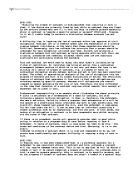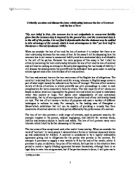Candidate No: Page 6/17/2007
First Coursework in Advanced Contract and Tort: Question 3
In this case the relationship created between Edith when she sends her package with Dodgy Carriers Ltd (“DCL”) is that of a bailment. A bailment is a possessory relationship by which the bailor (in this case Edith) transfers possession of a chattel to a bailee (here DCL). Here the bailment appears to be at will, in which case Edith has the right to call for return of the goods at any time. The problem in this case arises because the bailee (DCL) owes the bailor (Edith) a duty of care when handling the bailor’s chattels; here a package worth £2000. The action in this case of the package being stolen while in the possession of DCL is a clear breach of a bailee’s duty to take reasonable care of the chattel. This can be said because in the passage it states that ‘the package is stolen as a result of the carelessness of Fred, another employee of DCL’. This carelessness represents a failure by DCL and it’s employee’s to take the necessary reasonable care. Therefore DCL will be left with the liability of an insurer for the loss that occurred absent a valid exclusion clause.
It appears that exclusion or limitation clauses are the crux of the problem and their validity clearly determining the outcome in this case. Parties to contracts in English Law have used exclusion clauses for hundreds of years trying to manipulate contracts fairly and unfairly.
"All sensible people are selfish, and nature is tugging at every contract to make the terms of it fair."
The common law has constantly been monitoring clauses and refining rules for their regulation and raises a number of issues when considering liability. The first issue is whether the clauses were validly incorporated into the contract. Exclusion clauses may be incorporated into a contract by signature, by notice, or by course of dealing. In this case there is no evidence of a signature by Edith or evidence of a previous course of dealing between the two parties. Therefore for the two exclusion clauses in DCL’s document to be correctly incorporated they must be so by notice.
Before discussing the idea of notice it is necessary to examine how Kevin’s statement that DCL will “see (Edith) right” if anything happens to her package affects the validity of the first clause concerning value of goods. Without the second clause in this contract the ‘overriding assurance’ idea from the case of Curtis v. Chemical Cleaning & Dyeing Co. may be applicable although it is unsure as to Kevin’s apparent authority. The case illustrated the fact that a party who misrepresents (albeit innocently) the contents or effect of a clause inserted by it into a contract cannot rely on the clause of the misrepresentation. Obviously Kevin misrepresented the first clause but the company may still be exempted from liability if the second clause is found to be valid.
Proving that incorporation by notice has been satisfied depends upon whether the party receiving the document knows it contains an exclusion or limitation clause or was given reasonable notice. It would appear that in Edith’s case the document on which the clauses were printed was sufficient to constitute a contractual document; for a document to be perceived as contractual all that is required is that a reasonable person would perceive it as such. It would be reasonable to assume that Kevin’s handing over a copy of the standard terms and conditions would be perceived by Edith as constituting a contractual relationship. The next issue concerns degree: the extent to which the relying party draws the clause to the attention of the other party. All that is required is that he takes reasonable steps to do so. Reasonableness depends upon two factors: the steps taken to give notice and the nature of the excluding conditions. The test does not depend on whether the non-relying party has taken such steps, in the exercise of reasonable caution, as to discover the clause. As already identified the document is contractual, therefore the clause need only be set out prominently or referred to on the face of the document. The first clause set out in a large, red-bordered box obviously meets the condition and although the second is incorporated at the end of the document the fact that it is incorporated means Edith had sufficient notice. The final factor relating to notice of clauses is timing. The relying party must present the clauses to the other party before or at the time of contracting. This is illustrated in the famous case of Olley v. Marlborough Court where the claimant booked a room in the defendants’ hotel. She later saw a notice in her bedroom exempting the defendants from liability for articles lost or stolen unless handed to the management for safe custody. It was held that, as the contract was made at the reception desk and as the claimant could not see the notice in the bedroom until later, its terms were not incorporated. In Edith’s case, she is handed the standard terms and conditions before deciding to use DCL. Therefore the two clauses were presented to her before she contracted. Having considered all the factors required for sufficient notice it can be concluded that DCL gave Edith reasonable notice of the exclusion clauses and that she failed to read them is irrelevant.







